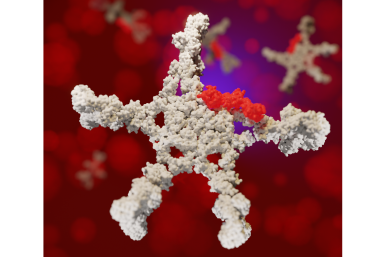Surprising Discovery: Key Antibody in Our Blood Holds Unexpected Properties
The structure of one of the most abundant antibodies in our blood, Immunoglobulin M (IgM), turns out to be different than previously thought: it contains an additional protein known as CD5L. This discovery, made by Utrecht University researchers under the guidance of Albert Heck and colleagues at Sanquin in Amsterdam, is now published in the scientific journal PNAS. Beyond the need for adjustments in biochemistry and immunology textbooks, this newfound understanding also carries implications for therapeutic applications.
First step immune response
When a pathogen like a virus or bacterium infiltrates our body, IgM is the first antibody produced by our immune system. One way IgM prevents infection is by binding to a pathogen. This binding hinders the pathogen from attaching to a cell, consequently preventing it from entering that host cell.
Surprise
IgM has been studied in laboratories worldwide for decades. During the 1990s, the antibody’s structure was thought to have been accurately identified: it is a very large molecule resembling a pentamer, a ‘starfish’ with five arms. This depiction found its way into all textbooks. While it was previously known that CD5L could bind to this ‘starfish’ structure, the recent research led by Utrecht and Amsterdam researchers has now unveiled, for the first time, that CD5L binds to all IgM molecules present in the bloodstream.
The researchers were genuinely surprised by the discovery. Heck: “Being the first to uncover something like this makes you question how that is possible. IgM has been extensively studied by thousands of people. Why are we the first to see this?”

A wide array of tests
At the same time as the Utrecht scientists, researchers at Sanquin also noticed something was wrong with the structure described in textbooks. Heck: “We thought it was really odd. However, when we learned that they had encountered the exact same thing, we could not just overlook it anymore.”
The two teams decided to collaborate to uncover what was really happening. They combined various techniques. Heck’s research team, which excels in determining the mass of large and complex molecules like IgM, revealed the absence of a small protein in the antibody’s structure. The Sanquin researchers devised methods to differentiate between freely circulating CD5L in the blood and CD5L bound to IgM. Additionally, the researchers observed that the concentrations of IgM and CD5L in the blood consistently fluctuated in sync.
Questions
According to Heck, this discovery gives rise to numerous new key questions. While IgM is produced by B cells, specialized immune cells, it remains unclear where CD5L is synthesized and where it becomes associated with IgM. The role of the CD5L protein within the context of IgM is also not fully understood at this point.
Interestingly, IgM in saliva and milk is not bound to CD5L at all. Heck offers some potential explanations for this: “It is speculative at this point, but it might represent a form of fine-tuning. Antibodies are locally adapted to the pathogens they encounter most frequently. And the bacteria present in your blood differ from those in your mouth or on your skin.”
These findings cast a new perspective on previous studies concerning so-called free CD5L.
Furthermore, CD5L could function as a sort of transportation pass. Heck: “Perhaps IgM relies on CD5L to enter the bloodstream, or maybe CD5L needs to be presented to facilitate its transition from the bloodstream to milk or saliva.”
Implications
The teams involved intend to continue their investigation into the formation and function of CD5L. But the newfound insights carry implications that extend beyond the scope of just this group of researchers. Heck: “These findings cast a new perspective on previous studies concerning so-called free CD5L, suggesting some of these studies might need to be reinterpreted. Moreover, companies currently manufacturing IgMs as therapeutic antibodies will need to make sure they are producing the correct molecule. And depending on CD5L’s exact role, there might be an opportunity to develop IgMs designed specifically for the bloodstream or for saliva.”
Blind spot
Reflecting on it, Heck does not find it all that surprising that something established decades ago turns out to be not entirely accurate: “With the significantly enhanced techniques we use today, there is always the possibility of uncovering new insights. On the other hand, when you revisit publications from recent years with current knowledge, it becomes clear that this discovery could have been made earlier. It underscores the importance of not blindly accepting what is written in textbooks, as you might overlook crucial details.”

